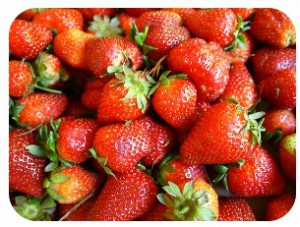 The family-owned berry grower Driscoll’s is looking to become more of a household name. With new packaging and a retooled online presence, the company wants to let the U.S. know why their berries are unique. “You have to find a way to say this strawberry is different from that strawberry, which isn’t necessarily an easy thing to do,” said executive vice president Soren Bjorn. “But our strawberries actually are different — no one else grows the strawberries we grow.” Along with their supposedly superior taste, Driscoll’s berries are bred to look good as well. While their raspberries are pinker and shinier than the competition, their strawberries have been developed over the years into a uniform shape.
The family-owned berry grower Driscoll’s is looking to become more of a household name. With new packaging and a retooled online presence, the company wants to let the U.S. know why their berries are unique. “You have to find a way to say this strawberry is different from that strawberry, which isn’t necessarily an easy thing to do,” said executive vice president Soren Bjorn. “But our strawberries actually are different — no one else grows the strawberries we grow.” Along with their supposedly superior taste, Driscoll’s berries are bred to look good as well. While their raspberries are pinker and shinier than the competition, their strawberries have been developed over the years into a uniform shape.
For American consumers, the physical appearance of fruits and vegetables can be even more important than their taste. After all, a shopper cannot take a bite out of an apple in the grocery store. If a particular apple looks appetizing, though, they’re more likely to buy it. That’s why Driscoll’s marketing revamp places just as much emphasis on the appearance of their fruit as its taste. But despite its prevalence among both growers and shoppers, this focus on raising perfect produce leads to immense waste in farms across the country. In fact, by some estimates one-quarter of all fruits and vegetables grown in the U.S. are either left to rot in the field or trucked directly to landfills due to issues with appearance. When added to the amount of food thrown out annually by retailers and consumers, almost half of all produce grown domestically ends up in the garbage uneaten.
“It’s all about blemish-free produce,” said Jay Johnson, a shipper of fruits and vegetables operating in the South. “What happens in our business today is that it is either perfect, or it gets rejected. It is perfect to them, or they turn it down. And then you are stuck.” Supermarket representatives largely claim that they are acting in the interests of consumers: if they don’t want to buy ugly fruits and veggies, why should those items get stocked in the first place? According to some activists, however, retailers may be more interested in retaining profits rather than catering to customers. “If you and I reduced fresh produce waste by 50%… then supermarkets would go from [a] 1.5% profit margin to 0.7%,” said Roger Gordon of Food Cowboy, a startup that rescues rejected produce. “And if we were to lose 50% of consumer waste, then we would lose about $250bn in economic activity that would go away.”
For their part, a growing number of supermarket chains have installed their own “ugly food” sections for items that would be considered unfit for standard stocking. Along with independent operators like Gordon’s Food Cowboy, the goal is to change the idea that a “uniform” strawberry or apple exists.
Questions:
- Why would a reduction in food waste potentially lead to a drop in profits for supermarkets?
- How does marketing from companies like Driscoll’s affect the way Americans think about fruit?
Sources: Stephanie Strom, “Driscoll’s Aims to Hook the Berry-Buying Shopper,” The New York Times, September 6, 2016; Suzanne Goldenberg, “Half of All U.S. Food Produce Is Thrown Away, New Research Suggests,” The Guardian, July 13, 2016. Photo by Fried Dough.
